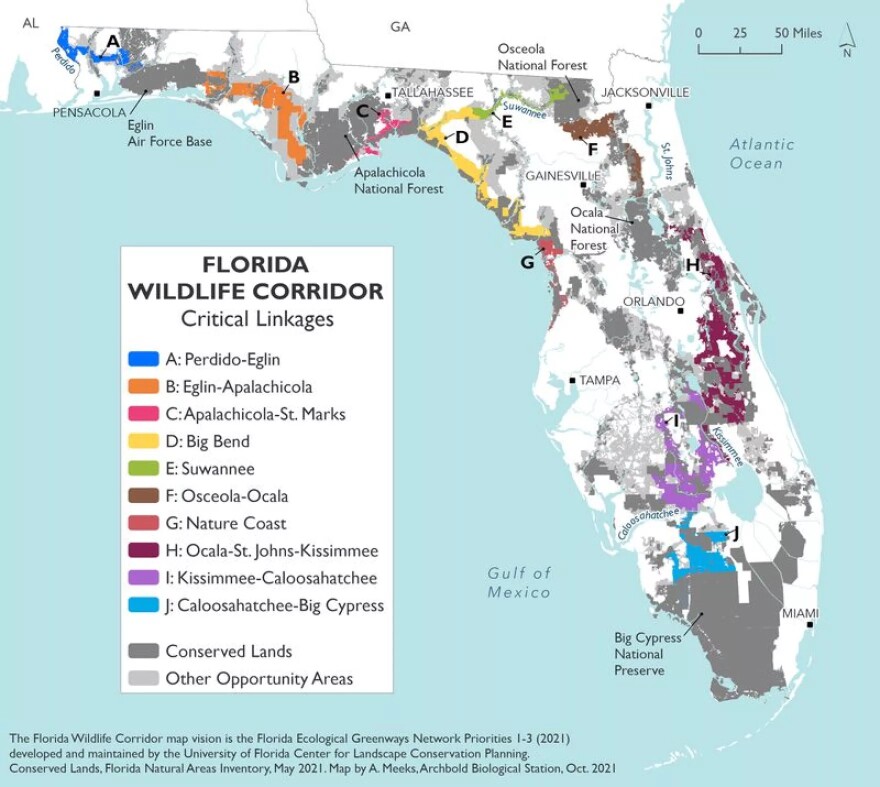A grant awarded this week to a local conservation group could go a long way toward preserving land in the Peace River Valley. This area supplies drinking water to several counties in Central Florida.
The federal grant of $21 million will be matched by grants from the state Department of Agriculture, and another $5 million has been pledged by the Division of State Lands. That means about $47 million could potentially be used to protect lands from being gobbled by development in several counties, including Polk, Hardee, DeSoto and Charlotte.
Jim Strickland is a sixth-generation cattle rancher in Manatee County and vice president of the Florida Conservation Group, a consortium of scientists, ranchers, and conservationists.
"Peace River supplies the drinking water for about 1 million people. So looking at the lack of conservation lands in the heart of in the heart of Florida, and looking at the significance of the Peace River Valley, that I think this is a void that absolutely needs to be filled," Strickland said.
"Across this region, we got hit by Hurricane Milton. We got hit by Helene. And there's a there's a lot of people that lost their orange groves, lost their crops. So I think it's a desire to save land, but it's also a desire to financially, to get back into saddle."

Strickland said since much of this area has been altered by phosphate mining, much of the lands they will target will include citrus groves and cattle ranches. They could use conservation easements, which allow the land to continue to be used but prohibit any development.
"So it's very important, but not only to us in the ranching industry, which that's what I am as a rancher, but in the conservation world, but also in the in the political world, because they understand the significance of what happens in the middle of state, either affects the communities on the Atlantic side or on the Gulf of Mexico side," Strickland said. "And $21 million sounds like a lot of money, and it most certainly is. But there is a lot of agricultural lands that are very interested in doing conservation easements, and this will certainly be well spent money, and I do believe it will be quickly spent."
The matching grants will come from the Rural and Family Lands Protection Program at the Florida Department of Agriculture and Consumer Services.
"Our Rural and Family Lands Protection Program was created to permanently preserve Florida's natural resources and safeguard our food supply, and this partnership is a testament to our ongoing commitment to this mission,” said Commissioner Wilton Simpson.
“Through collaboration and by combining resources from state, federal, and private partners, we’re keeping more of Florida’s natural landscapes intact and prosperous for generations to come."
Incoming Florida Senate President Ben Albritton is from Wauchula in Hardee County and is a fourth-generation farmer.
"The commitment shown by the Florida Conservation Group and their partners to safeguard the Peace River Valley exemplifies the best of our state's dedication to preserving vital agricultural lands and natural resources,” Albritton said in a prepared statement.
“This Regional Conservation Partnership Program funding, combined with support from state programs like the Rural and Family Lands Protection Program and Florida Forever, marks an extraordinary step toward ensuring the long-term protection of these lands. Together, we are setting a powerful precedent for conservation that will benefit Floridians for generations to come."

The convergence of Saddle Creek and the Peace Creek Drainage Canal in northern Polk County marks the beginning of the Peace River. Flowing through Hardee, DeSoto and portions of Polk and Charlotte Counties, the Peace River flows roughly 100 miles south where it feeds into the Charlotte Harbor estuary, making it the largest freshwater contributor to the harbor.
To date, Florida Conservation Group has partnered with agencies and landowners to protect more than 37,000 acres in the Peace River Valley.
“The open lands of the Peace River watershed are significantly threatened by southwest Florida’s growing population; ranches are being replaced by rooftops faster than they can be protected,” said Julie Morris, the Group's executive director. “Support from programs offered by FDACS, DEP and NRCS, along with our state leadership, has been instrumental in gaining attention for conservation efforts in this area. The award is critical to achieving our goals in the region and maximizing the amount of land protected forever.”




